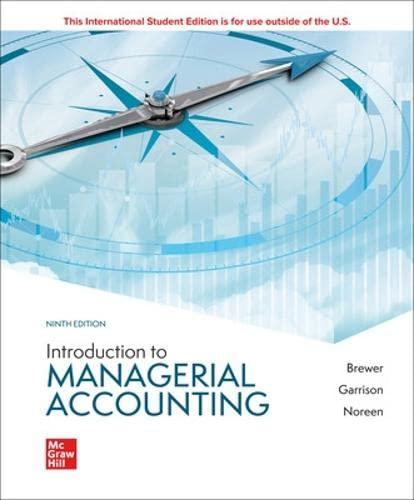PROBLEM 216 Plantwide Predetermined Overhead Rates; Pricing LO21, LO22, LO23 Landen Corporation uses a job-order costing system.
Question:
PROBLEM 2–16 Plantwide Predetermined Overhead Rates; Pricing LO2–1, LO2–2, LO2–3 Landen Corporation uses a job-order costing system. At the beginning of the year, the company made the following estimates:
140,000 70,000
. $784,000
$2.00
$4.00 During the year, Job 550 was started and completed. The following information is available with respect to this job:
. . . . . . . . . . . . . . . . . $175
. . . . . . . . . . . . . . . . $225 Direct labor-hours Machine-hours Manufacturing overhead costs Direct labor-hours Machine-hours . . . . . . . . . . . . . . . 15 . . . . . . . . . . . . . . . . . 5 Required:
1. Assume that Landen has historically used a plantwide predetermined overhead rate with direct labor-hours as the allocation base. Under this approach:
a. Compute the plantwide predetermined overhead rate.
b. Compute the total manufacturing cost of Job 550.
c. If Landen uses a markup percentage of 200% of its total manufacturing cost, what selling price would it establish for Job 550?
2. Assume that Landen’s controller believes that machine-hours is a better allocation base than direct labor-hours. Under this approach:
a. Compute the plantwide predetermined overhead rate.
b. Compute the total manufacturing cost of Job 550.
c. If Landen uses a markup percentage of 200% of its total manufacturing cost, what selling price would it establish for Job 550?
3. Assume that Landen’s controller is right about machine-hours being a more accurate overhead cost allocation base than direct labor-hours. If the company continues to use direct labor-hours as its only overhead cost allocation base what implications does this have for pricing jobs such as Job 550?
Step by Step Answer:

Introduction To Managerial Accounting
ISBN: 9781265672003
9th International Edition
Authors: Peter C. Brewer , Ray H. Garrison, Eric Noreen





